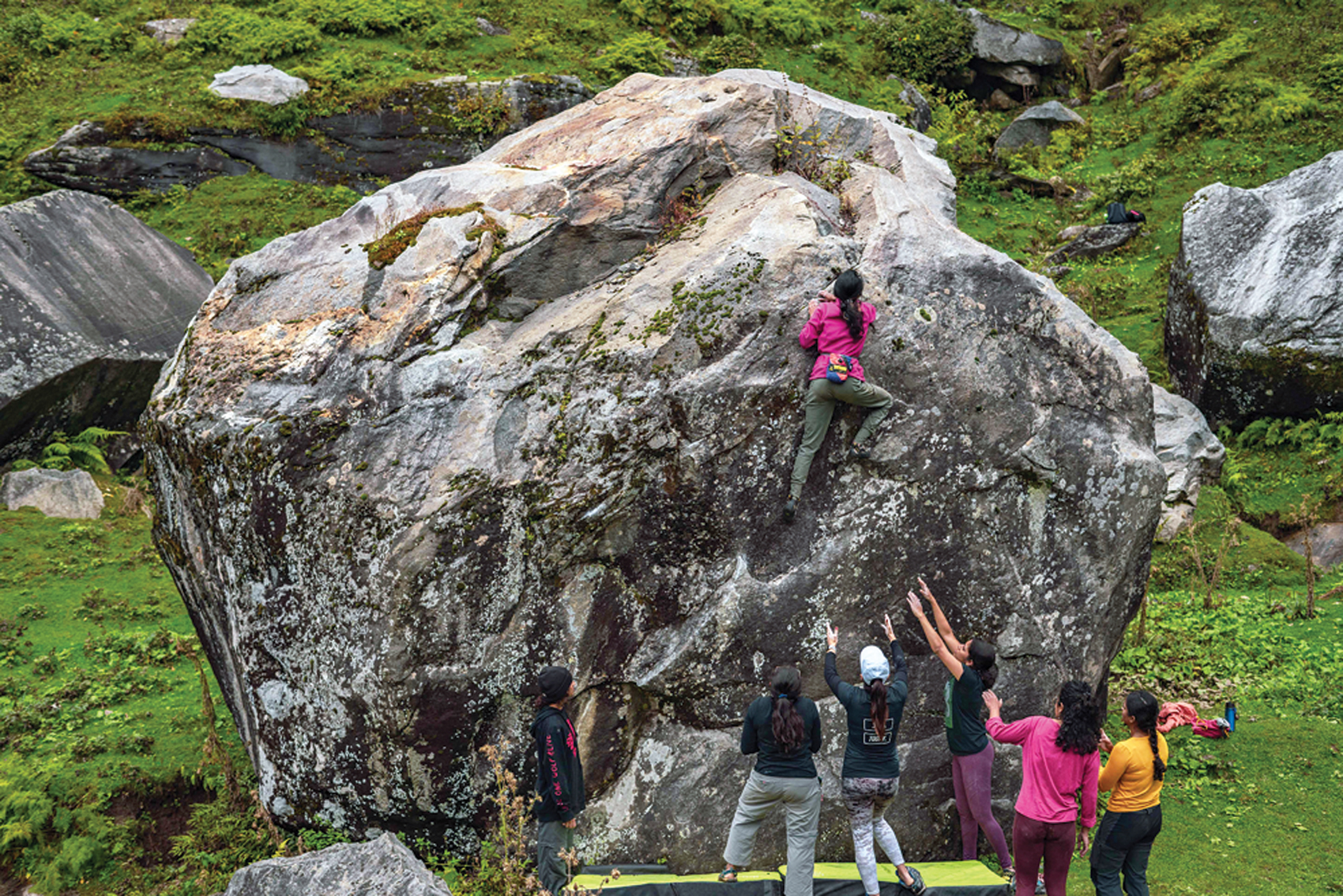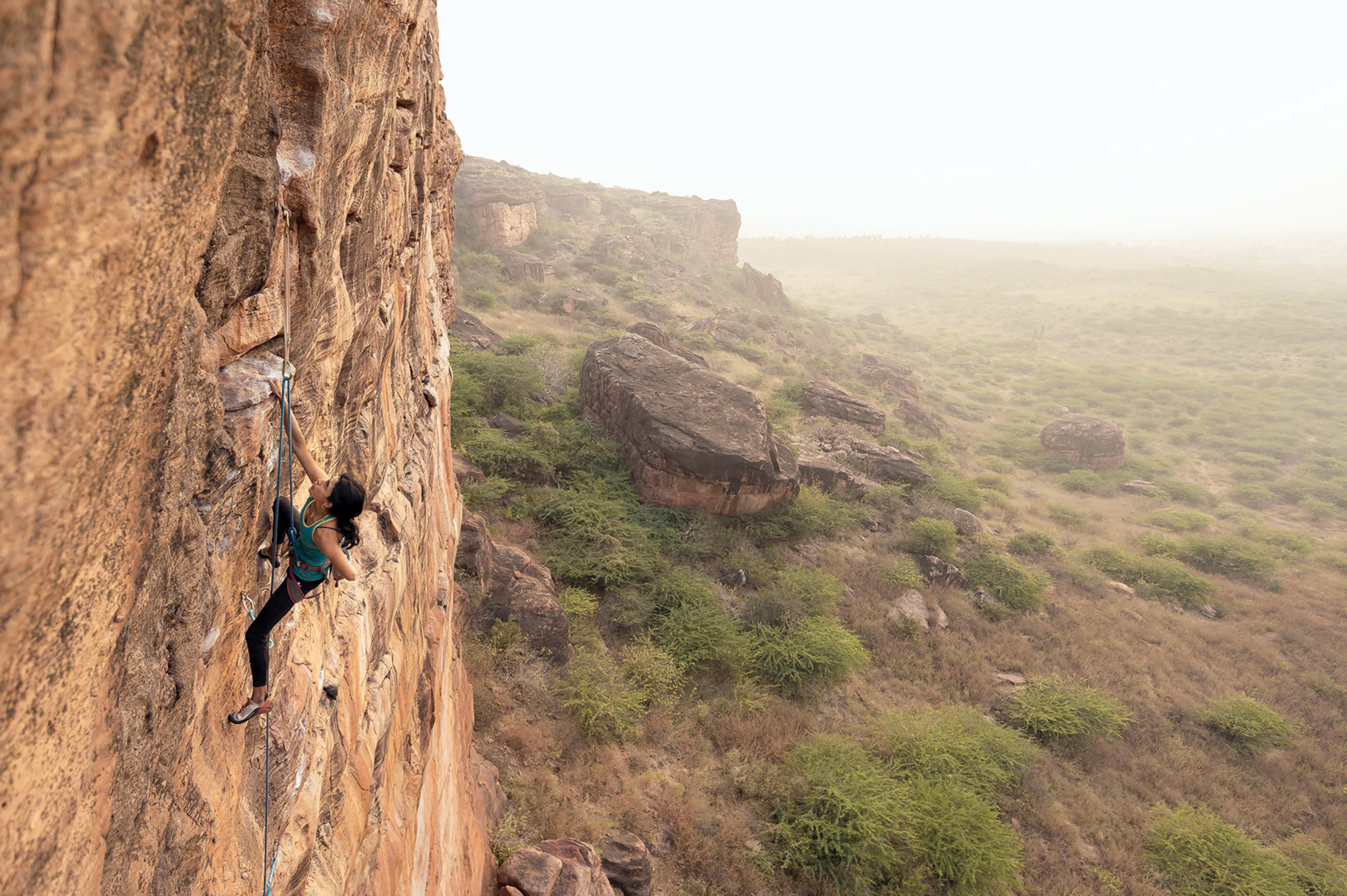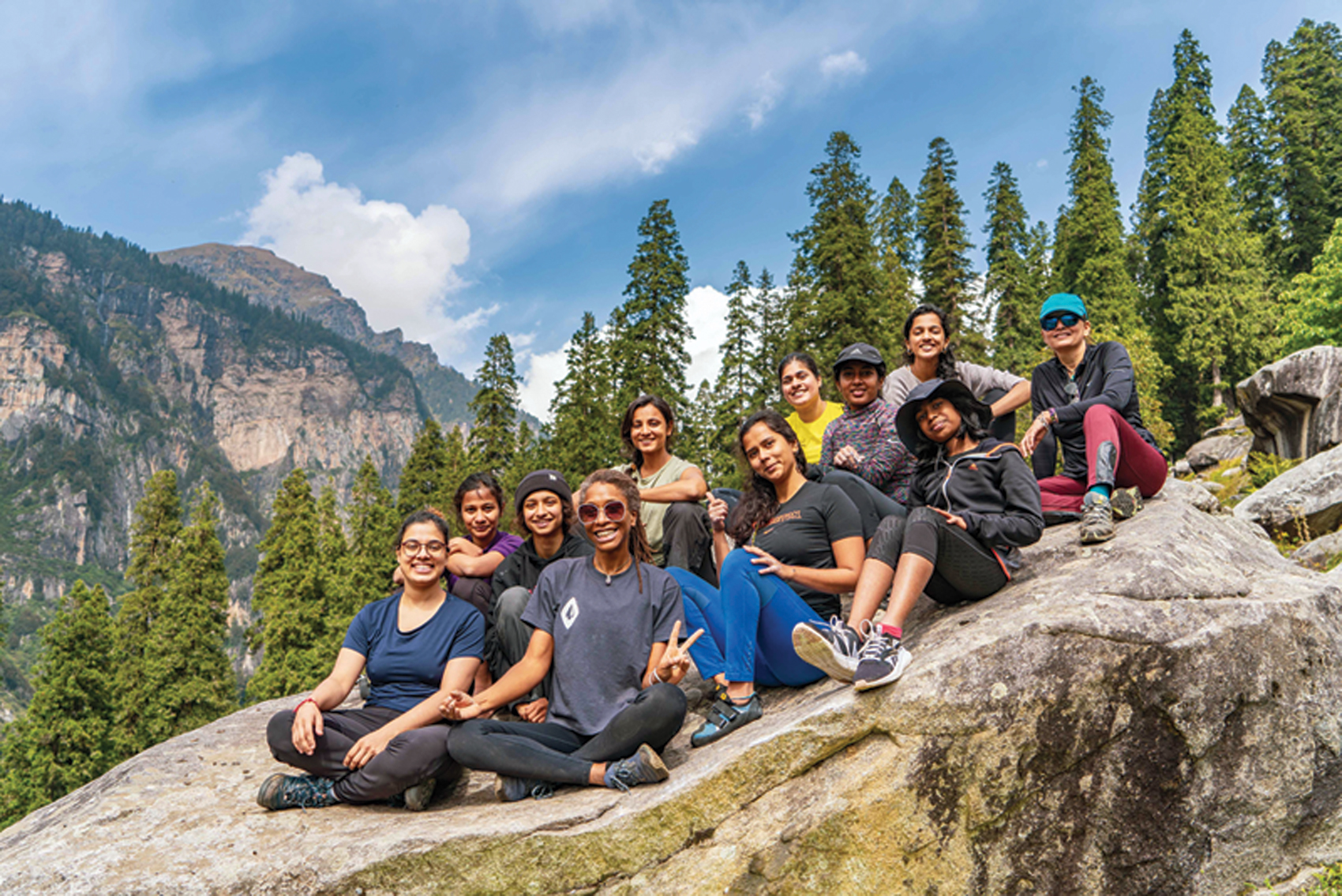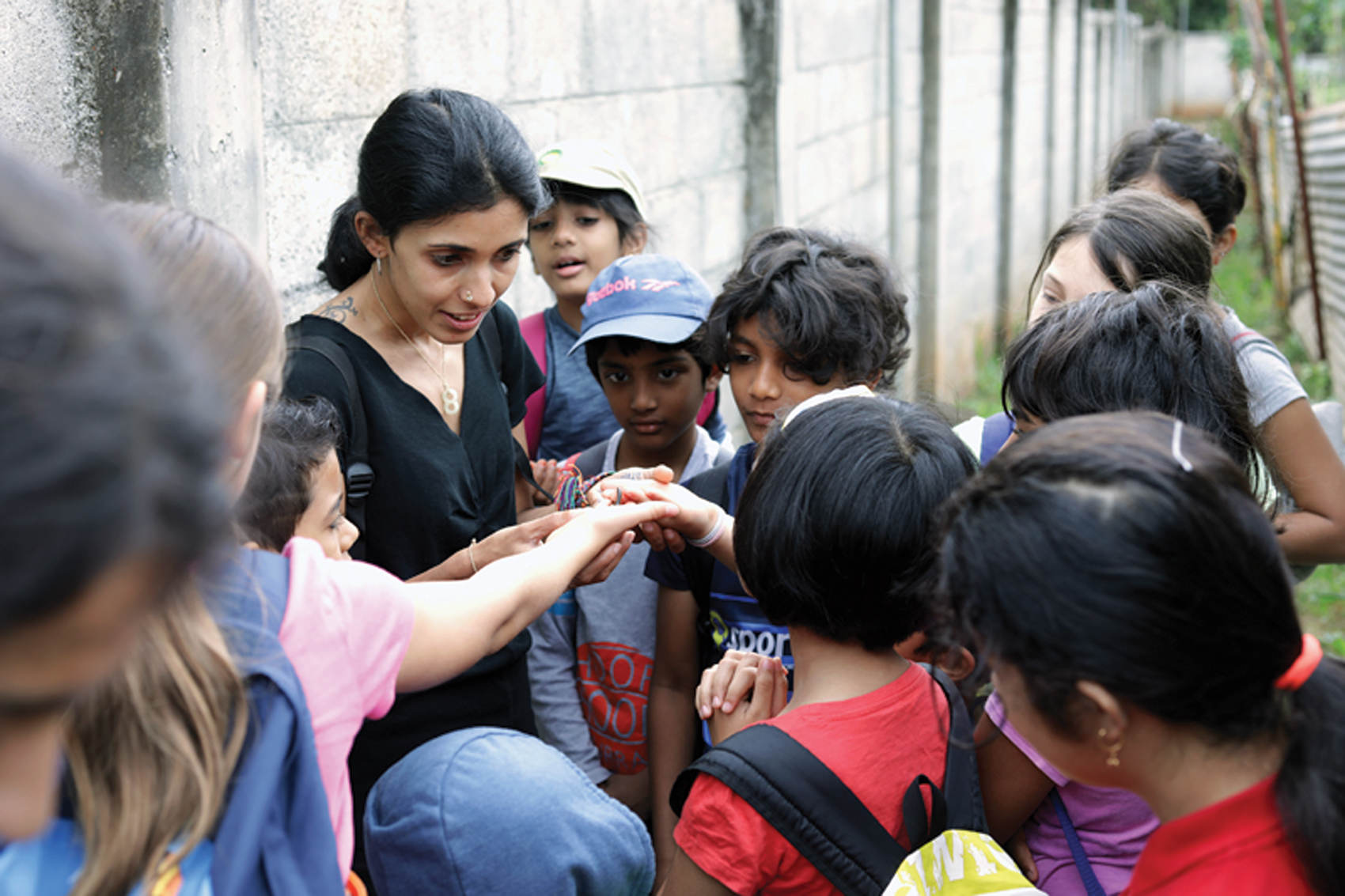Climbing Back To Our Roots
First published in Sanctuary Asia,
Vol. 42
No. 4,
April 2022
By Gowri Varanashi
It was a particularly hot day in Badami as I stood at the other end of a staircase in front of a temple on a hillock with stunning red sandstone rock walls towering on either side. I could see a few people huddled under one wall as they watched my friend Arjun Reddy, leading up a sport route. Suddenly, I heard him calmly call out, “there is a snake in this crack.” We climbers often stick our fingers, hands and feet – and on rare occasions, entire body parts like our knees and shoulders – into crevices as they make for very good holds. Most people would be scared, but my friend slowly backed off and the snake slithered away into the crevice. We identified it as a harmless racer. Although I am familiar with snake identification, I was unable to narrow it down to the exact species. Someone with snake handling experience gently picked it up and handed it over to me. I took this opportunity to educate others, including a few locals, about this beautiful reptile. Months later, I found out that it is an uncommon species called the Nagarjuna racer.

Participants of CLAW 2021 supporting each other during the event. The author founded ‘Climb Like A Woman’ (CLAW) in 2018, to introduce Indian women to this adventure and skill, and enable women to break barriers and challenge themselves in a ‘safe space’. Photo: Gayatri Juvekar.
The climbing-nature connection
I have always been passionate about spending time in nature and observing wildlife. Experiencing, learning and sharing the mysteries and surprises of this planet brings me happiness. I found climbing around eight years ago and since then, I have been uncovering the connection between my climbing journey and my affinity to all things wild.
Rock climbing became a medium that pushed my limits in natural settings. Recognising this potential of climbing to empower, I, along with Lekha Rathinam, Prerna Dangi, Vrinda Bhageria and Mel Batson began CLAW (Climb Like a Woman) in 2018 to introduce Indian women to this amazing skill and adventure. I witnessed first-hand how climbing enabled women to break barriers and challenge themselves in a ‘safe space’. Scaling a rock face is a type of movement that requires the use of both mind and the entire body. It is not unusual to find us in obscure locations around our bustling cities, lugging strange gear, drawing confused looks from locals who probably wondered why we did not just walk up using an easier route from the back. This seemingly simple challenge of climbing can be difficult, both physically and mentally, and it is up to each individual to decide the degree to which they push themselves.
Rocks are Nature
“Rock climbing is a form of nature connection to me because rocks are nature. Although they are not living or breathing as such, they are an integral part of the environment because it is a natural object, made of natural minerals and crystals infused together. They play a key role in our ecosystem because they often become a home or shelter to various animals, including birds, spiders, insects, lizards, geckos or even larger animals like bears and leopards that use the caves or crevices to rest. These rocks are also a substrate for microscopic organisms such as lichen (which is made up of fungus and algae living together in symbiosis). What is amazing is that rocks were created millions of years ago and so they have been around longer than most things on this planet.”
– Gowri Varanashi
Once, I scaled up a 76 m. super vertical cliff, a route called High Exposure in the Shawangunks in the United States. As I inched closer to the top, my friend, who had gone up ahead of me, softly whispered that a Peregrine Falcon was awaiting my arrival. Treading gently so my noisy arrival at the top would not cause it to fly away, I clambered up to see the falcon a foot away from me, staring right into my eyes. It was a beautiful moment between me and the raptor as the sun set above the huge cliff. I came to realise that rock climbing itself is a form of nature connection and offered a great opportunity to teach people about animals, plants, and landscapes. After all, what can be better than scaling larger-than-life rock formations, hundreds of metres above the ground and often in fabulous natural settings (see box above)!

Climbing for sport is still mostly a male-bastion, though this is gradually changing. Climbers like the author are creating more opportunities for women to join the climbing community. Photo: Kiran Kallur.
Lessons from nature
I believe our journey back to nature begins with our immediate surroundings…spiders, trees, birds… every living thing with which we share space. Growing up on a wild campus at an alternative school called Centre for Learning in Bengaluru, I recall teachers granting us freedom and encouraging us to study nature. One year, I documented all the butterflies on campus. Another year, I studied snakes. At 15, while relocating a bamboo pit viper away from our school building, a friend and I helped release it and I recall our fear and excitement when we gently touched its tail as it slithered away. Growing up with such experiences, seeing leopards and bears on campus, hearing a hyena’s cackling calls and spotting slender lorises and chameleons, all contributed to my love and passion for the wild. As the climate crisis and environmental disasters increasingly threatens us, I believe returning to our roots, redefining our relationship with nature will be even more vital to human survival.
I had a huge “aha” moment during one of our outdoor trips; that climbing and other outdoor recreations can be an excellent medium to communicate and teach people about the importance of urban green spaces and about ‘Disturbance Ethnobotany’. I first learned of this term with relation to herbalism and medicinal plants. Disturbance Ethnobotany is the study of plants and trees in anthropogenic habitats or ‘disturbed habitats’ of urban areas. This means looking at plants, usually labelled as weeds, that thrive in gardens, sidewalk cracks, walls, building ruins, fields or any place disturbed by humans. Sadly, many of these “weeds” are overlooked, when in reality, they are a treasure trove of food, medicine, dyes and more. Plants have innumerable useful properties that we still do not completely understand.
CLAW
Climb Like A Woman was initiated by Gowri Varanashi and four other women climbers in 2018. She and her team of five are striving to encourage women to break barriers through rock climbing. They teach Indian women rock climbing through the annual CLAW event. In this five-day event, beginners can learn the basics and safety techniques of climbing, and practice unstructured climbs with other climbers in the area. CLAW also teaches slacklining, highlining and yoga, and creates space for discussions on why women are challenged in our society and culture to do things that don’t fit into the typical expected gender roles. CLAW is currently working on continuing to break barriers and empower women through climbing and also build a community and networking system of support for women all over India. Toward this, they started Claw Local Teams, selecting women to provide support and guidance to other women. They have also started providing various types of climbing grants to women, the first one being the ‘Just Climb’ grant, which supports women who have just started their climbing journey by covering some of their expenses. You can check out CLAW on Instagram (@climblikeawoman) or on their website www.climblikeawoman.com!
Cannabis, for example, is called “weed”. It is, in fact, a weed that grows wild in Himachal Pradesh. During CLAW 2021, I taught participants to forage for cannabis stalks, process them for fibre and make ropes out of them. Everyone was shocked that we could forage and create fibre from plants growing wild. We also foraged stinging nettle, considered a nuisance because it has fine hairs that release stinging oil that irritates our skin. This plant is one of my favourite “weeds” for its medicinal and nutritious properties as a food. Cannabis reduces internal inflammation, is an antioxidant, contains vitamins A, C, K, calcium and iron, helps alleviate joint pain and much more. Nettles can be dried and used as a delicious mild-flavoured tea, and can be consumed in place of spinach. I would often make a creamy nettle pesto for pasta. There are more weeds that we can use, such as word sorrel, red clover flowers, wild spinach… the list is endless!

CLAW women at the summit of a boulder in Sethan, Himachal Pradesh. To empower women through climbing, CLAW Local Teams was initiated, selecting mentors to guide and support other women interested in climbing. Photo: Gayatri Juvekar.
Examining the disconnect
Why do these misconceptions exist? Why are we disconnected from nature today? My readings led me to the term ‘nature deficit disorder’, first coined by Richard Louv in his book, Last Child in the Woods. I came across another in Phra Paisal’s Temple School, a small booklet written by the Tibetan monk Phra Paisal Visalo, whose words deeply impacted me. He spoke of people who give more importance to material consumption while pursuing happiness. Meanwhile, our lifestyles cause us to be more distanced from the natural world. This disconnect has far deeper, unseen implications and consequences than we realise.
A point that really resonates with me is how the loss of our spiritual connection to nature is the basis of human suffering today. This brought me to an epiphany – how today’s biggest environmental challenge is not just the climate crisis, or the degradation of our rainforests and oceans, but in the fact that we have lost much of our spiritual connection to nature. We act without knowledge or care for the consequences of our actions.

Children excited to hold a millipede for the first time! Besides CLAW, the author also runs a project called Wilderness Ways, with the aim to educate and reconnect people back to nature. Climbing, says the author, is an excellent medium to teach people about the importance of urban green spaces and about the plants and trees in disturbed habitats. Photo: Shreekrishna K.V.
Looking upwards and onwards
I wish to change this in ways I know best. By reawakening my senses and connecting to nature on a deeper level, through experiences, going back to our roots, our age-old systems that taught us skills like fibre-making, fire-making, shelter-building, valuing plants we now consider weeds and by foraging sustainably.
I commenced my long journey back to traditional knowledge systems, sustainable living, awareness and sensitivity to the earth. And this is what led me to start Wilderness Ways. Change starts at different levels for different individuals. It depends on our willingness to open ourselves, unlearn what has been conditioned in us, and relearn what we have lost. This process exists at some level or other in each one of us. In my case, curiosity about nature was awakened through meaningful outdoor experiences.
Wilderness Ways
Wilderness Ways was founded by Gowri Varanashi in 2020 to educate and reconnect people back to nature. She teaches nature education using unique techniques adapted from Wilderness Schools in the U.S., where she taught these programmes for the last four years. A combination of sensory activities and games are used to teach children and adults to learn about their own senses, slow down, learn to observe themselves and their surroundings, and achieve mindfulness. Along with this she brings teachings of ancient ways or survival skills, such as fire making, shelter building, rope making, basket making, primitive cooking and more, and these take people back to their roots and allows them to view nature with a new perspective of value and resources. Science and nature knowledge are weaved in throughout these lessons, to start participants on the path of becoming a naturalist. You can check out Wilderness Ways on Instagram (@wilderness__ways) and the website www.wildernessways.org.





